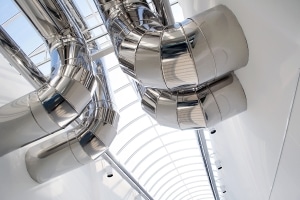
Ventilation Systems
Planning of ventilation & aeration systems
Ventilation systems fall under the installation group 3 of the HOAI. As already mentioned at the beginning, they serve to supply certain areas with air. The systems can be divided into 2 groups: Room air technology (VDI Ventilation Rules) and process air technology. Process air technology is part of the manufacturing process. It involves the extraction, drying, separation or conveying of air, depending on the requirements of the production process. Process air technology systems are part of the production systems.
What are room air technology systems?
These are technical systems that are used to supply fresh outside air to living rooms, offices or production areas and to discharge used or polluted air (exhaust air) to the outside. Room air technology systems are part of the technical building equipment.
The required air flow rate is calculated and depends on the demand. In addition to ventilation systems that serve to supply fresh air and/or discharge exhaust air, there are also pure air recirculation systems in which no fresh air is supplied, but the room air is recirculated and, for example, cleaned and humidified.
Different types of ventilation systems
Free ventilation systems
These systems are based on the natural exchange of air between the room air and the outdoor air. The exchange takes place through windows or ventilation slits or in the form of joint ventilation through cracks and gaps in windows and doors.
Technical equipment for free ventilation systems are for example shaft ventilation or roof ventilators.
Free ventilation systems use thermal or pressure differences. The rate of air exchange fluctuates greatly and cannot be controlled. Waste heat cannot be recovered.
Supply air systems
The heart of these room air technology and air conditioning systems are fans, which are used to direct air into the interior of the building. On this occasion, the air can be given additional properties. For example, it can be heated or cooled, humidified or dried. If the air is cooled and humidified, it is a partial air conditioning system. Coarse and fine air filters and electrostatic precipitators are often an integral part of supply air systems. These clean the air of insects, pollen and dust.
Exhaust air systems
Prime examples of pure exhaust air systems are ventilation systems in public toilets or sanitary facilities in office buildings, social facilities or production plants. Other areas of application are smoke extraction systems, fume cupboards in laboratories or ventilation systems in underground car parks. In the private sector, extractor hoods with exhaust air function fall into this category.
Supply and exhaust air systems
Combined operation is very common in practice. Such systems are often combined with heat recovery equipment. Depending on the design, between 40 and 90 percent of the heating energy used can be recovered.
Components of the ventilation systems
The heart of the systems are fans or blowers which provide the forced air exchange. Almost as important are air filters, which are supposed to protect people and equipment from harmful impurities in the supply air. Sensors indicate when the filters must be replaced. Ventilation flaps close automatically when the system is switched off. Fire dampers must also be installed between individual fire compartments.
Silencers are also necessary components in high-performance systems. While smaller ventilation systems are controlled by compact controllers, larger systems are integrated into the building automation and are controlled by DDC-GA electronic modules.
Hygiene in ventilation systems
The applicable provisions are laid down in VDI 6022. This regulates the responsibilities of the planner, installer and operator. Inspections, maintenance and cleaning work must be carried out at regular intervals. The aim is to prevent contamination with dirt and germs and to ensure that the system works properly.
Summary
Ventilation systems are used to supply fresh air to buildings or to discharge exhaust air. Very often systems work in combined operation. They provide sufficient moist, clean and unpolluted air so that people stay healthy and machines operate optimally. In combination with heat recovery systems, they can save at least 40 percent of heating energy (compared to systems without heat recovery). Larger ventilation systems are centrally controlled and are part of the building automation system. Ventilation systems play a very important role in kitchen ventilation technology and laboratory ventilation technology, but also in garage ventilation.



